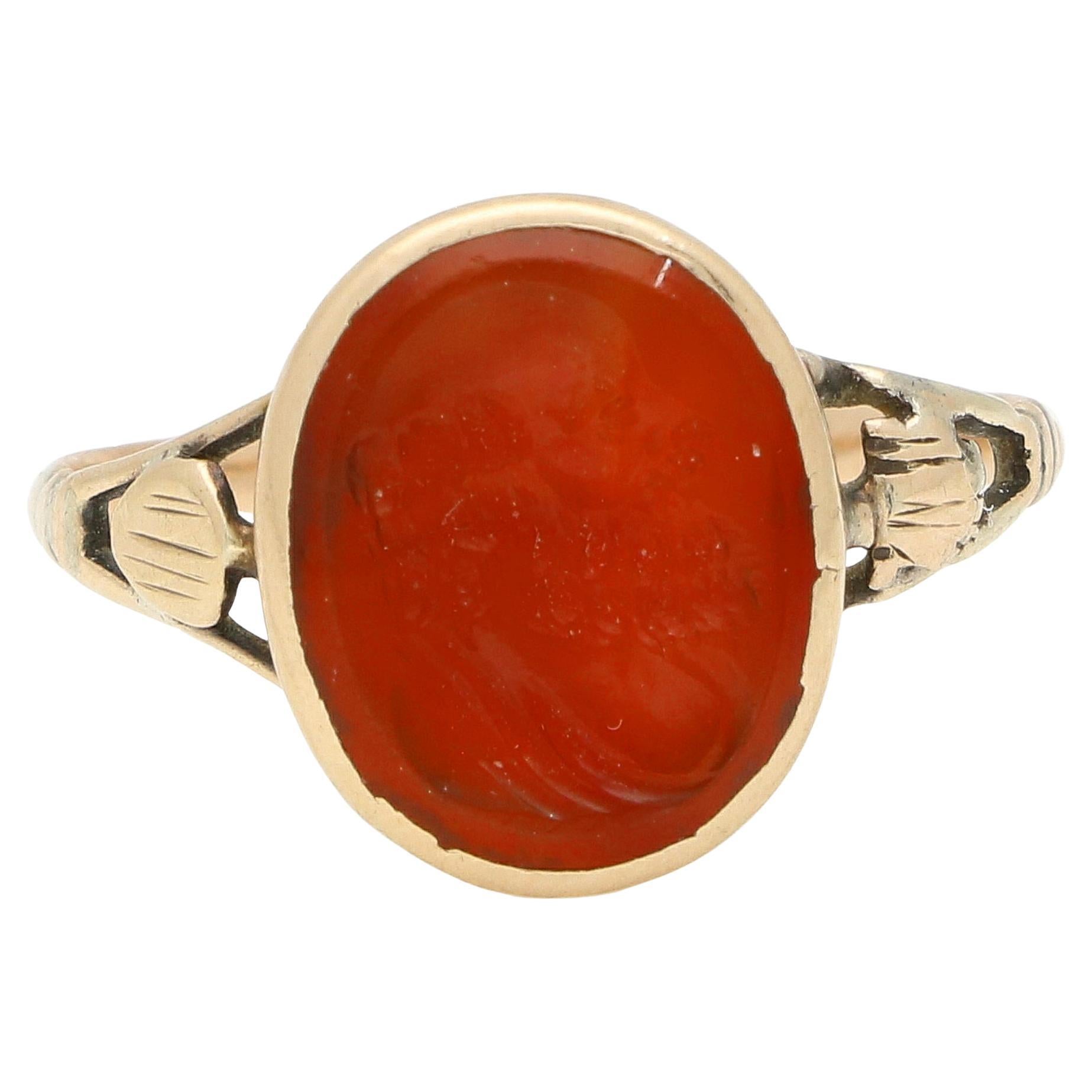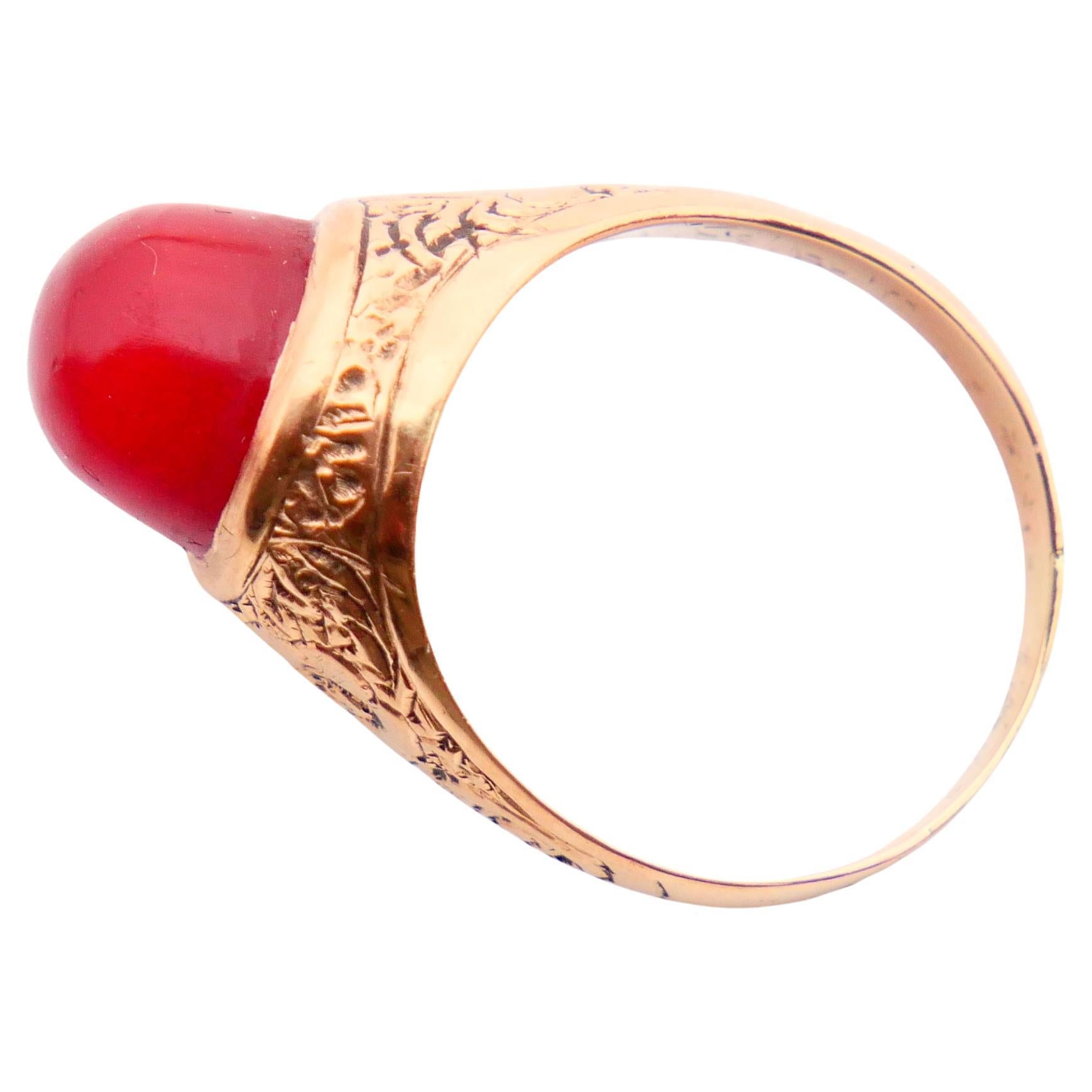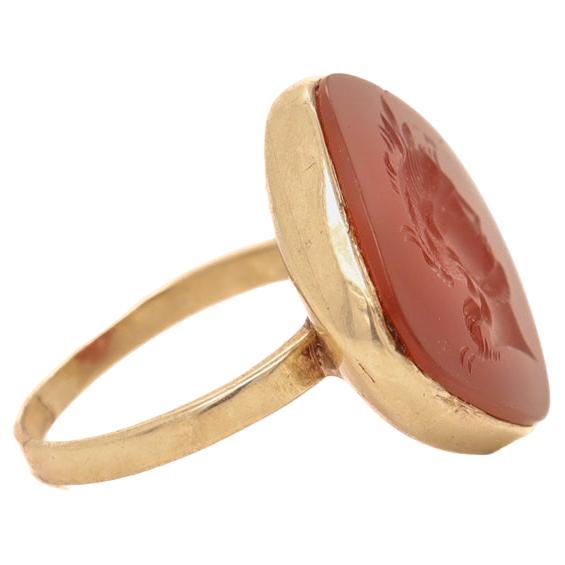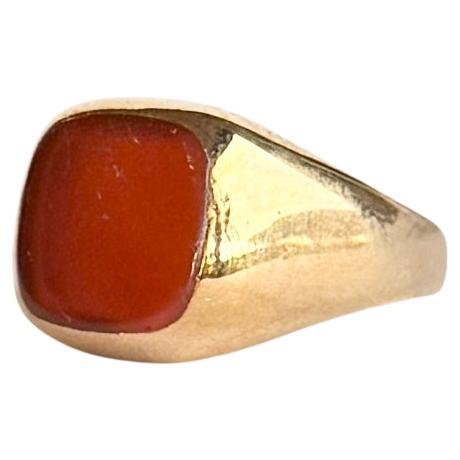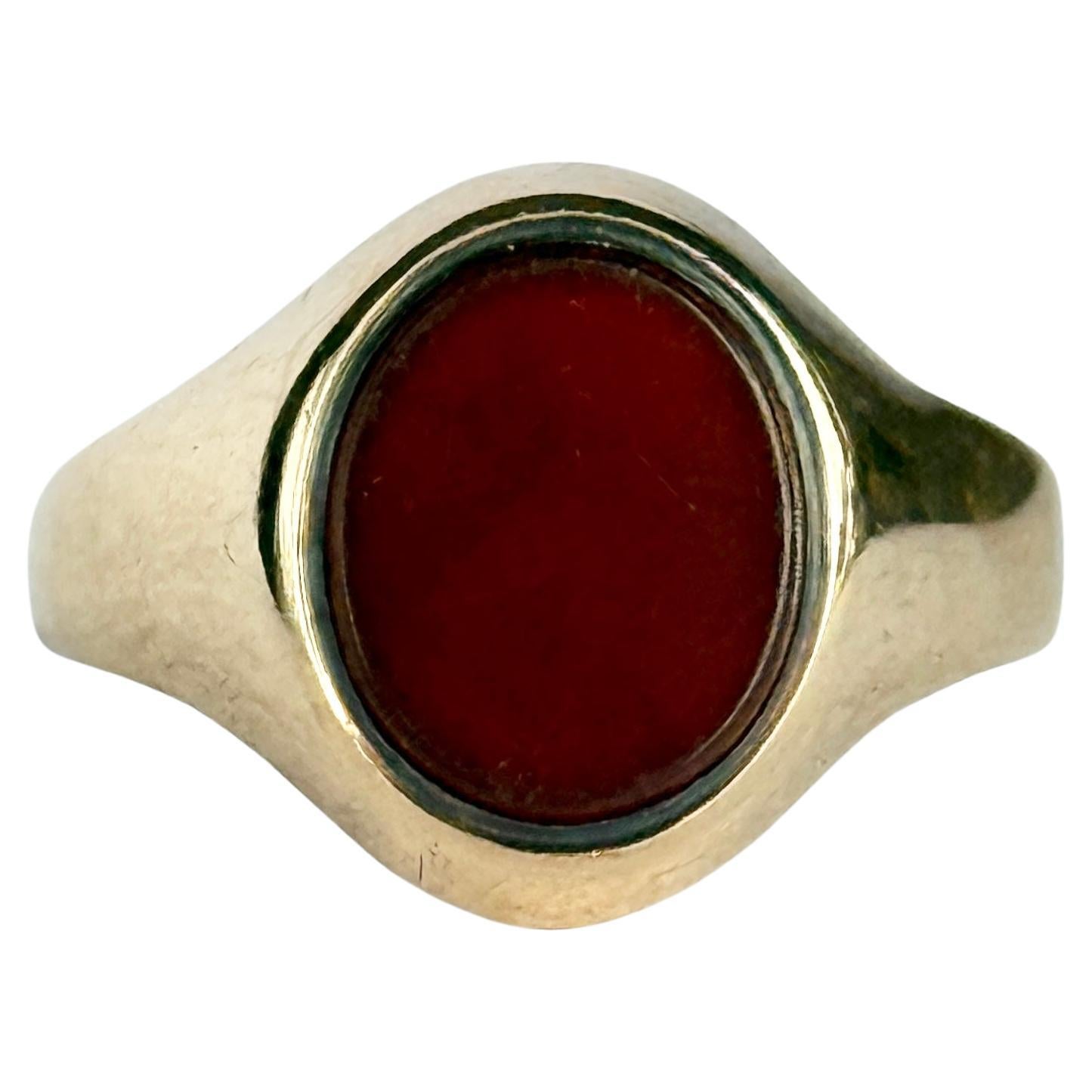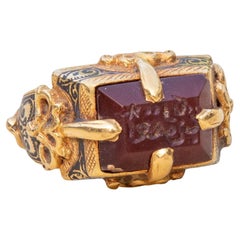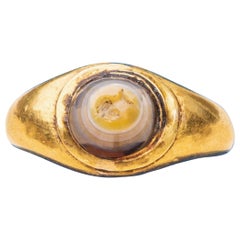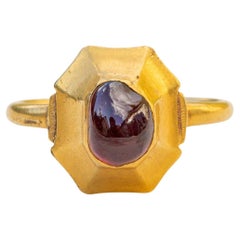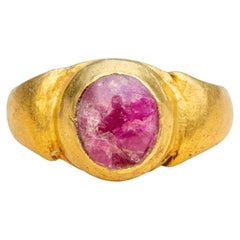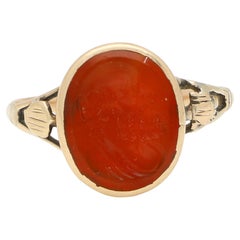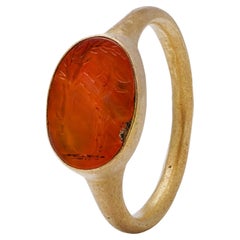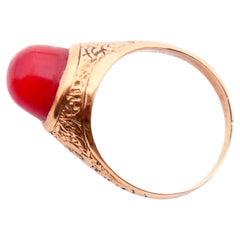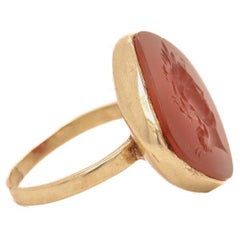Items Similar to Small Ancient Indus Valley Bead Ring Etched Carnelian Cone Antique Gold Ring
Want more images or videos?
Request additional images or videos from the seller
1 of 14
Small Ancient Indus Valley Bead Ring Etched Carnelian Cone Antique Gold Ring
$3,265.91
£2,400
€2,819.60
CA$4,486.80
A$5,009.09
CHF 2,624.69
MX$61,316.20
NOK 33,333.57
SEK 31,429.33
DKK 21,042.98
Shipping
Retrieving quote...The 1stDibs Promise:
Authenticity Guarantee,
Money-Back Guarantee,
24-Hour Cancellation
About the Item
A superb and rare ancient Indus Valley etched carnelian bead ring. The conical shaped carnelian gemstone in the centre dates from the middle of the third millennium BC. Deep orange in colour with white patterned etchings, these beads originate from the Indus Valley civilisation (parts of modern day Pakistan and India).
These carnelian beads were alkaline-bleached to develop the geometric white patterns visible on the exterior. The technique was first developed by the Harappans of the Indus Valley civilisation, and vast quantities have been found in archaeological sites all across the Indus Valley.
The conical stone has been set in a later high-karat gold ring mount, the hoop is hollow and of circular cross section which widens towards the bezel. This design and shape is typical of ancient gold rings, however this example would have most likely been made in the 18th or 19th century in keeping with the ancient style. The ring has a fantastic smooth silk-like texture when worn, and is of a particularly small finger size (see below for measurements).
Various similar examples reside in notable collections and museums such as the Louvre and British Museum.
UK size E, US size 2.25 (very small!)
The ring weighs 10 grams and the carnelian stone measures 10mm x 10mm x 5mm. The gold ring is stamped with French hallmarks and tests as 22K gold.
Carnelian served as the canvas for intricate etchings that conveyed the cultural and spiritual essence of the Indus people. Furthermore, Indus Valley etched beads are considered as an important marker of ancient trade between the Indus Valley, Mesopotamia and even Ancient Egypt, as these precious and unique manufactured items circulated in great numbers between these geographical areas during the 3rd millennium BCE, and have been found in numerous tomb deposits. More recently however, a study into a hoard of beads discovered at the site of Aegina-Kolonna in Greece (one of them being an etched carnelian bead) has provided new evidence for trade existing between the Indus Valley and Greece in the 3rd millennium BCE.
About the Seller
5.0
Vetted Professional Seller
Every seller passes strict standards for authenticity and reliability
Established in 2019
1stDibs seller since 2022
46 sales on 1stDibs
- ShippingRetrieving quote...Shipping from: London, United Kingdom
- Return Policy
Authenticity Guarantee
In the unlikely event there’s an issue with an item’s authenticity, contact us within 1 year for a full refund. DetailsMoney-Back Guarantee
If your item is not as described, is damaged in transit, or does not arrive, contact us within 7 days for a full refund. Details24-Hour Cancellation
You have a 24-hour grace period in which to reconsider your purchase, with no questions asked.Vetted Professional Sellers
Our world-class sellers must adhere to strict standards for service and quality, maintaining the integrity of our listings.Price-Match Guarantee
If you find that a seller listed the same item for a lower price elsewhere, we’ll match it.Trusted Global Delivery
Our best-in-class carrier network provides specialized shipping options worldwide, including custom delivery.More From This Seller
View AllAntique Gold Seljuk 12th Century Ring Carnelian Intaglio Kufic Islamic Signet
Located in London, GB
This incredible, rare gold ring dates from the 12th century Seljuk dynasty. The carnelian intaglio is set within a typical Seljuk tapered rectangular bezel with a four-pronged gold setting soldered to the outside of the bezel. Applied and pierced arabesque designs are placed at the bottom of each prong which also reinforce the joints.
Further applied gold Seljuk ornamentation decorates the band, including two gold birds and a highly decorative vestigial sprued bottom (back-knob) from the casting. The gold mount itself is also ornately and intricately chased and nielloed with arabesque patterns. Remarkably, the niello work remains in exceptional condition, and can still be seen on the underside of the bezel which is decorated with a lattice pattern.
The carnelian intaglio seal is flat cut base with bevelled sides. This shape was predominantly used in the seals from the 8th to 11th century. The seal is engraved with angular Kufic script with forked terminals which dates the seal to the 9th-12th centuries (Porter, 2011).
For similar referenced examples in museums and notable collections, see final photos, in particular item 26 in ‘Islamic Rings and Gems: the Benjamin Zucker Collection’ (1987).
UK size K, US size 5.25
The ring weighs 9.19 grams and is crafted in high-karat gold (21K gold). The carnelian stone measures 11mm x 8mm x 3mm. The hollow box bezel measures 16mm x 10mm and protrudes 7mm from the base.
This museum-grade ring is a rare survivor, most existing examples have some damage to the ring, intaglio or niello - this is a scarce example in superb, original condition.
The Seljuks, a Turkish dynasty of Central Asian nomadic origins, became the new rulers of eastern Islamic lands following the defeat of the powerful Ghaznavids at the Battle of Dandanakan (1040). Under the Seljuk sultanate, which spanned from the 11th to the 13th century, goldsmiths and jewellers created works of unparalleled beauty and sophistication. Seljuk jewellery...
Category
Antique 15th Century and Earlier Engagement Rings
Materials
Carnelian, Gold
Ancient Roman Gold Mens Signet Ring Conical Intaglio Ring Gem Carving
Located in London, GB
A superb ancient Roman agate intaglio ring. The high-karat gold signet ring is set with an engraved gemstone, known as an ‘intaglio’. It dates from between the 2nd to 3rd century AD and is a fine example of a Romano-British intaglio.
The conical-shaped agate gemstone displays various bands of colour ranging from honey brown to greyish-blue. The engraving depicts the bust of a man wearing a helmet, possibly winged which would depict Mercury, the Roman god of commerce, financial gain and communication. In Roman times, people would wear rings with the intaglio of Mercury in hope that the he would protect them and bless them with good financial fortune in their lives.
A number of referenced examples of similar ancient Roman conical shaped intaglios reside in notable museums all across the world, from the British Museum to the Louvre. A page with these examples and their sources can be found in the final photos of the listing. Similar examples can also be found in the extensive Alice and Louis Koch collection (items: 234, 235, 241, 301). Again see final images for reference.
The gold ring mount is of D-shaped cross-section and a hollow 22K gold construction. The ring has a fantastic smooth silk-like texture when worn. It remains in good overall condition and the intaglio is very secure in the mount. The gold mount dates to the late 18th to early 19th century, and the shape is inspired by ancient Roman ring...
Category
Antique 15th Century and Earlier Signet Rings
Materials
Agate, 22k Gold
Scarce Medieval Gold Garnet Ring Antique 13th Century Talisman Signet Ring
Located in London, GB
An exceptionally rare late 13th century Medieval period gold ring, made either France or England, circa 1280!
This Medieval high-karat gold ring is set with a large 11ct irregular-s...
Category
Antique 15th Century and Earlier European Engagement Rings
Materials
Garnet, 22k Gold
Ancient Javanese Gold Ring with Ruby Cabochon Java Indonesian Antique Solitaire
Located in London, GB
A scarce early Javanese gold and ruby ring dating from the 7th-15th century Indonesian Classical period.
As expected with Javanese gem-set gold rings m...
Category
Antique 15th Century and Earlier Javanese Signet Rings
Materials
Ruby, Gold
Antique Gold Engraved Carnelian Cherub Eros Intaglio Ring Signet Ring
Located in London, GB
A striking gold ring, dating from the early 20th century. The figural shoulders are adorned with angelic putti motifs, delicately sculpted to depict Eros, the Greek God of love and d...
Category
Early 20th Century Classical Roman Engagement Rings
Materials
9k Gold
Antique Indian Gold Ruby Cabochon Ring Mughal Period
Located in London, GB
A scarce late Mughal period Indian gold and ruby ring dating from the mid-19th century.
The cabochon cut ruby is belcher set in an open-backed mount and weighs approximately 1ct. Th...
Category
Antique Mid-19th Century Indian Late Victorian Engagement Rings
Materials
Ruby, Gold, 22k Gold
You May Also Like
Antique Carnelian Intaglio Signet Ring in Yellow Gold
Located in London, GB
An antique carnelian intaglio signet ring made in 9k yellow gold.
A true piece of history, this exquisite ring features a beautifully carved carnelian intaglio stone set in a classi...
Category
Antique 1880s Late Victorian Signet Rings
Materials
Carnelian, Yellow Gold
Roman 22kt. gold ring with goat carnelian intaglio
Located in Braintree, GB
Roman 22kt. gold ring with goat carnelian intaglio.
Circa 100 - 300 AD.
A lovely carnelian stone intaglio engraved with a goat rearing up a palm tree, set in a gold ring of a thin ...
Category
Antique 15th Century and Earlier European Signet Rings
Materials
Carnelian, Gold
Antique Ring Carnelian solid 18K Orange Gold Ø US 5.5 / 5.1gr
Located in SE
Unusual Antique Ring adorned with bezel set polished Red nipple of natural dark Red Carnelian stone Ø 10 mm x 7.7 mm deep mm / ca. 5 ct. Color of...
Category
Vintage 1920s Swedish Art Deco Signet Rings
Materials
Carnelian, 18k Gold
Antique Gold & Carved Carnelian Intaglio Signet Ring with an Ancient Roman Hero
Located in Philadelphia, PA
A fine antique intaglio ring.
Likely converted from an antique button or pin.
In 14k gold
With a carved carnelian cabochon depicting an unidentified Roman hero.
Marked 14k to the...
Category
20th Century Etruscan Revival Signet Rings
Materials
Carnelian, Gold
Vintage Carnelian and 9 Carat Gold Signet Ring
Located in Chipping Campden, GB
The deep red carnelian is complimented perfectly by the 9ct yellow gold in this signet ring.
Ring Size: K 1/2 or 5 1/2
Stone Dimensions: 9x9mm
Weight: 4.8g
Category
Vintage 1980s British Signet Rings
Materials
Carnelian, Gold
Vintage Carnelian and 9 Carat Gold Signet Ring
Located in Chipping Campden, GB
The deep red carnelian is complimented perfectly by the 9ct yellow gold in this signet ring. There is engraving on the inside of this ring reading 'TO DAD WITH LOVE 25.12.76'. Hallm...
Category
Vintage 1970s British Signet Rings
Materials
Carnelian, Gold
More Ways To Browse
Carnelian Ring Egypt
Rare Antique Cameo Rings
Renaissance Intaglio
Mens Sapphire Signet Ring
Vintage Art Deco Mens Ring
Antique Signet Ring Men
Masonic Signet
Mens Gold Cross Ring
Antique 18 Karat Gold Signet Ring
B Signet Ring
Intaglio Lion
Large Intaglio Ring
Men Lion Ring
Mens Emerald Signet Rings
Antique Victorian Mens Ring
Fortuna Jewelry
Intaglio Ring White
Minerva Ring
